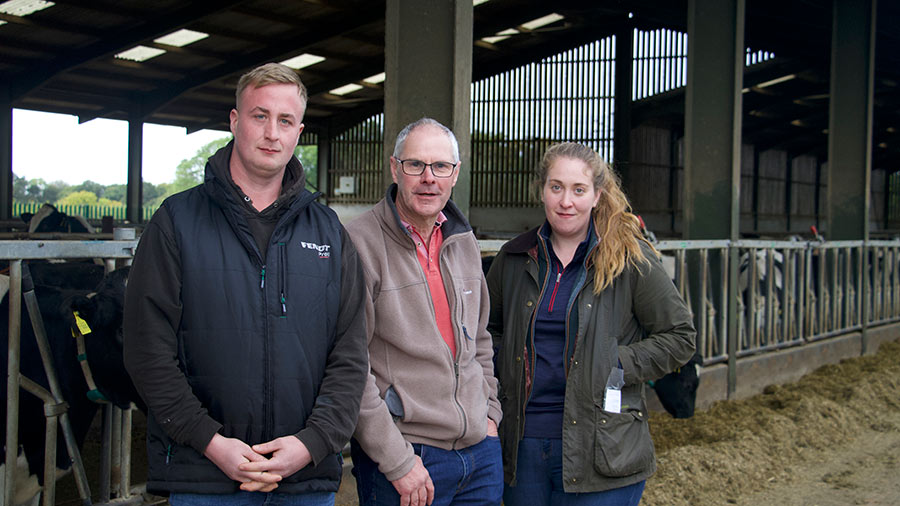How a Cheshire dairy is calving heifers at 23 months
 From left to right: Herdsperson James Raven, business owner Jeremy Platt and chief calf rearer Fiona Armstrong © Rhian Price
From left to right: Herdsperson James Raven, business owner Jeremy Platt and chief calf rearer Fiona Armstrong © Rhian Price Jeremy Platt and the team at Lea Hall Farm, Wimboldsley, Cheshire, are focused on solid heifer performance to average 23 months at first calving.
Setting the foundations for this is good colostrum management at birth: calves are fed three litres of pasteurised colostrum within the first two hours.
All colostrum is tested, pasteurised and frozen, then thawed immediately before use with a coloQuick machine.
“If you are going to invest any money, invest in one of these machines,” advises Mr Platt.
See also: Advice for ensuring heifers are the correct weight after calving
After a second feed, calves then move to an automatic milk machine where they are fed 150g of skimmed milk powder/litre of water.
Manager Les Furber explains that by day 14, calves are at peak consumption, being fed 8.5 litres of milk a day.
“The milk machine is only as good as the person looking after it,” says Mr Platt, who reiterates that it must be checked regularly for calves that have not fed.
Farm facts
- Milking 1,400 cows across two dairies
- A third farm is used as a youngstock unit
- Selling milk to Muller/Sainsbury’s
- Yielding 12,000 litres at 3.8% butterfat and 3.3% protein, on average
- Three-times-a-day milking
Weaning
Weaning is a step-down process starting at 56 days: over a 12-day period milk is gradually reduced by 0.4 litres a day.
Calves are supplemented with ad-lib pellets from day one, alongside finely chopped straw fed ad-lib.
At 90 days, calves are moved in batches of 25-30 to the youngstock unit at Lea Hall Farm.
Here, they move onto a total mixed ration (TMR) of grass silage, straw, half blend (24% crude protein) and half heifer rearer pellets (18% crude protein).
“The percentage of protein depends on the grass silage,” says Mr Platt. “This year, the blend is higher. We put some of the nuts in the TMR and that has helped that diet transition. Gradually, calves move across to 100% blend.”
Once in-calf, they are turned out to graze. They are moved back inside and put on a transition diet three weeks before calving.
Calf and heifer health
Good vaccination protocols are key to preventing any check in growth. At seven days, calves are vaccinated against pneumonia, and a repeat dose is given at weaning.
Heifers also receive ringworm, bovine viral diarrhoea, leptospirosis and infectious bovine rhinotracheitis vaccines.
Heifers are foot-bathed with formalin once a week, which has brought down overall digital dermatitis in the herd.
Mr Platt says: “In a group of 100 we might have seen one or two [cases], but it is very contagious, so we didn’t want to leave it unchecked.
“We stamped on it quickly and started foot-bathing weekly, and we don’t see any digital dermatitis in our heifers now.”
Calf growth rates are averaging 800g-1kg/day, with animals weighed at birth and then every quarter.
At 11-12 months, heifers are served twice with sexed semen, followed by Aberdeen Angus semen.
Rearing costs
Rearing costs have escalated over the past eight months, going from £1,360 to £1,920.
“We have added in more cost with vaccinations, but we are achieving a more consistent animal and a faster turnaround,” explains Mr Platt.
“You want to rear your heifers as efficiently as possible at the cheapest cost. Rearing costs have mostly gone up on the back of higher feed costs and labour.
“I’m hoping the growth gains we make will counter that cost. It’s still cheaper to rear them then operate a flying herd, and we are not bringing in unknown diseases. Plus, you have a pool of heifers to pick from.”
Figures
- Average age at first calving: 23 months
- Age at service: 11-12 months
- Total calf losses 5%
- Average growth rate: 0.8kg/day
- Pregnancy rate for cows: 25%
- Pregnancy rate for heifers: 32%
- Conception rate to first service on heifers: 52%
- Heifer rearing costs a head: £1,920
- Herd replacement rate: 25%
This article was written from a recent AHDB event hosted by Jeremy Platt.
Events on calf health are still running on the AHDB website.
